If you want to learn how to make Indian restaurant curries at home this is the place to start. Indian restaurant curry base or base gravy is the foundation of the whole thing. Get this figured out and you are on your way to making better curries than you can buy.
Indian restaurants cook a whack of different curries to order. Ever wonder how they do it? For sure they don’t have 25 curries simmering away in the kitchen.
Nobody can run a restaurant like that. They have a secret. Indian restaurant curry base.
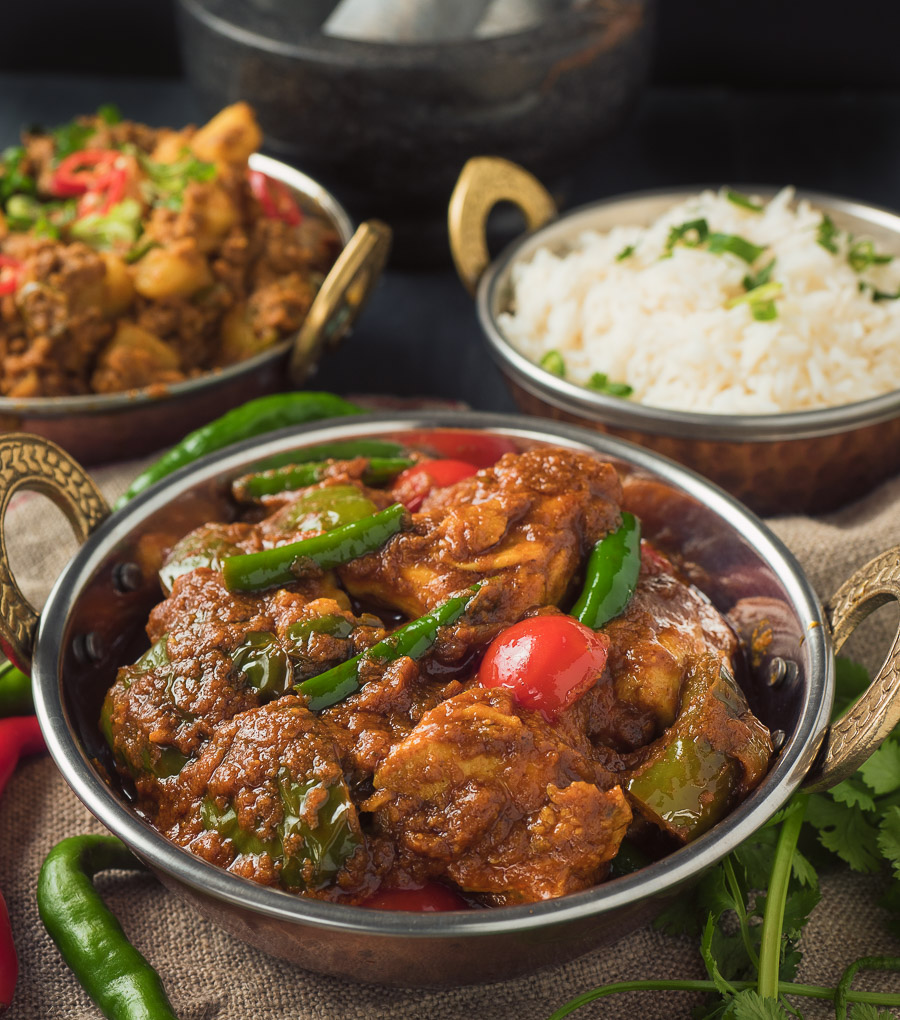
Curry base is how Indian restaurants can cook to order
It’s cooked to order and it’s done using curry base. Curry base is at the heart of every Indian restaurant kitchen. Giant pots of it simmering away.
Once I heard about it I started asking waiters. I met kitchen staff. Talked about it with a chef or two. I was on the inside. Now you are too…
Never heard of curry base? Not surprising. For the longest time it was a closely guarded secret. Even now, Indian restaurant curry base recipes are carefully guarded secrets.
A hint of carrot – ooohhhh. A bit of cabbage – aaahhh. A green pepper – ssshhhh. But that’s how it’s done.
It’s a bit ridiculous. In it’s simplest form it’s just a lot of boiled onions with some spices and oil. Seriously. Cook it up and it tastes like a weak curry onion soup. Nothing to it. Not particularly tasty.
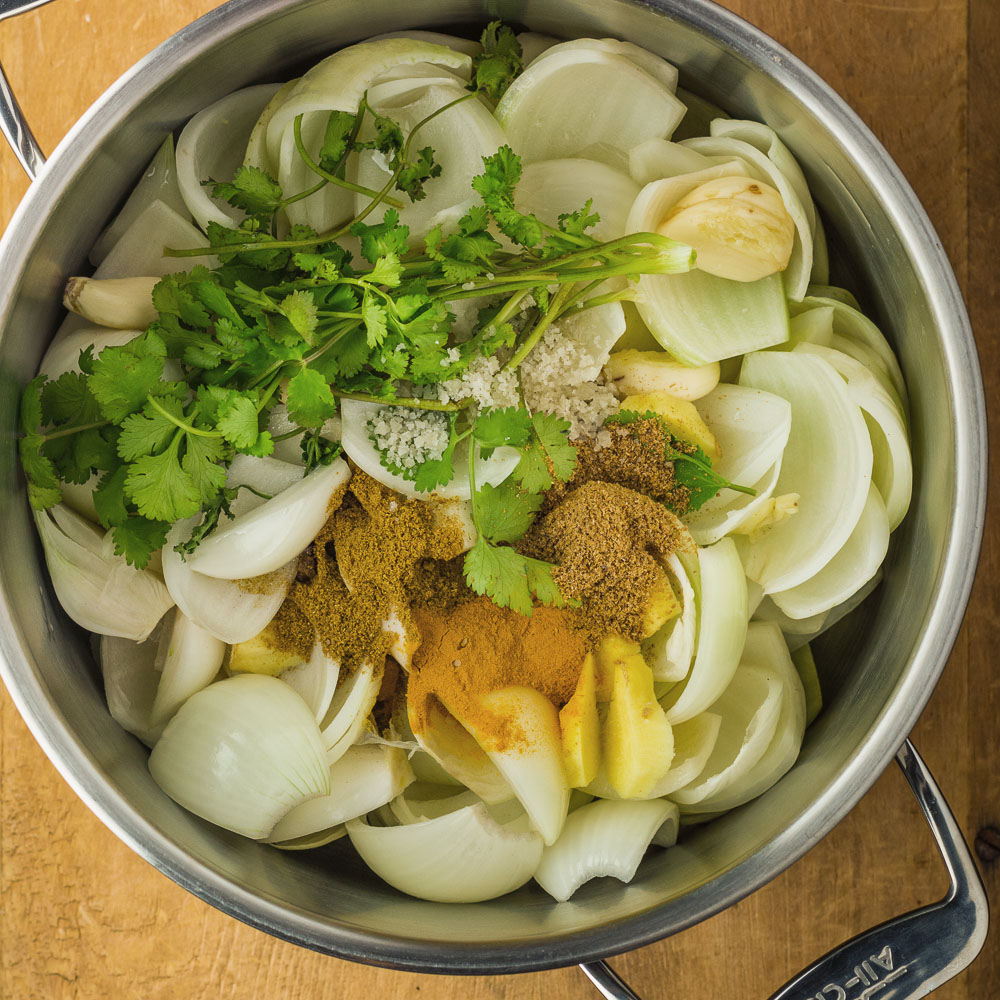
The magic is in the cooking technique
But when you layer the Indian restaurant technique on top it’s magic. Something wonderful happens to that insipid onion soup. It caramelizes. The Maillard reaction kicks in. The depth of flavour is – well it’s restaurant quality.
It’s not hard. It’s just a matter of rolling up your sleeves and getting it done. Chop some onions. Add some water and some seasoning and boil. Puree. Boil some more. Done.
You can get a quick lesson on cooking Indian restaurant curry here.
You use this base in recipes like Indian restaurant madras, lamb curry, jalfrezi or chicken tikka masala. Look around – there are lots of Indian restaurant curry recipes here.
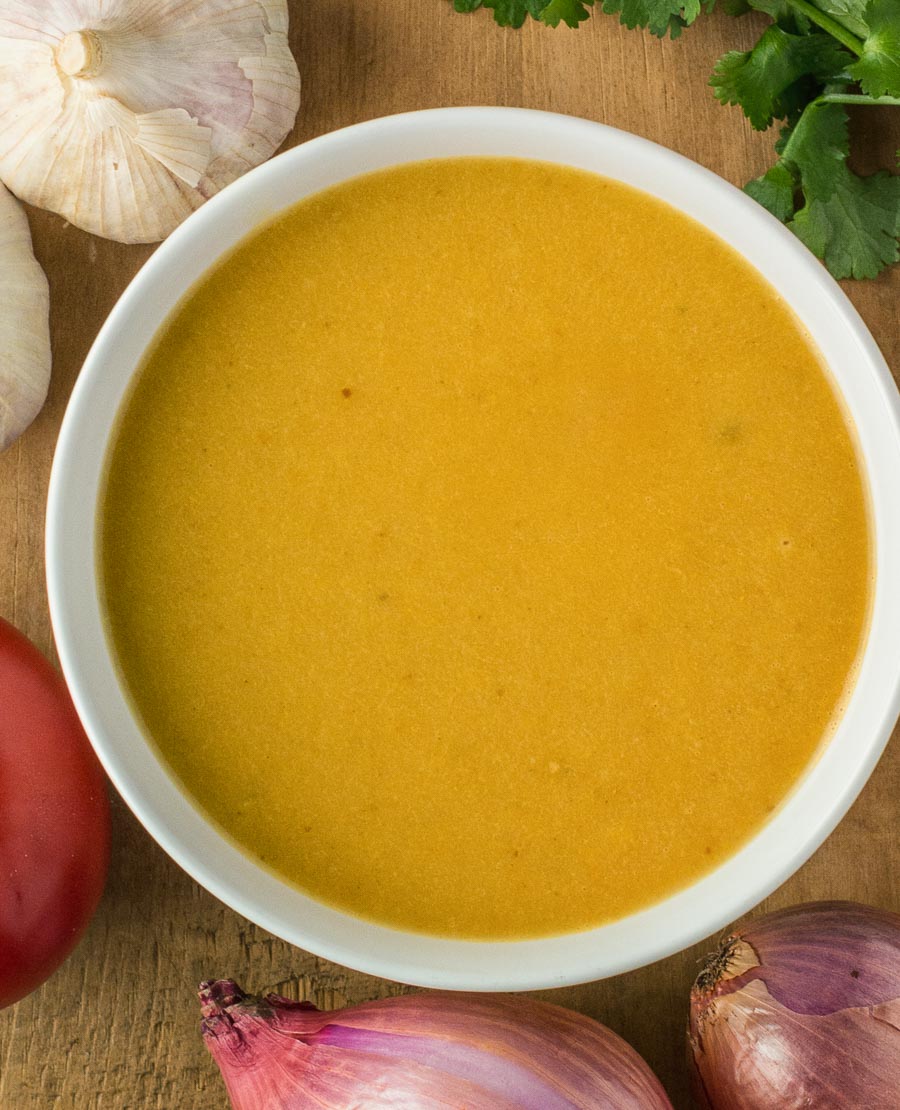
One thing to note. Indian restaurant curries are big on oil. This recipe is about as low as you can go on the oil. Don’t use less. It just won’t work. Indian restaurant curry is a lot of things but low calorie it is not.
If you want to cook Indian restaurant style curries this the first step. The real deal.
Watch the video (there’s real audio)
indian restaurant curry base
Ingredients
- 8 large onions – about 2.5 lbs peeled weight
- 6-8 cloves garlic peeled
- 1 1/2 Tbsp ginger coarsely chopped
- 1 1/2 Tbsp cumin powder
- 1 1/2 Tbsp coriander powder
- 1 1/2 tsp turmeric
- 1 1/2 tsp salt
- 12-15 fresh cilantro stalks with leaves – roots removed
- 1 cup vegetable oil
- 12 cups boiling water
- 15 oz can diced tomatoes – one small can
Instructions
Step 1
- Bring the water to a boil (a kettle works well for this).
- Quarter the onions and then break them apart into petals (roughly – two or three petals per quarter)
- Combine all ingredients except tomatoes, bring to a gentle boil and simmer, loosely covered, for one hour. Use a big pot!
- Add tomatoes, stir and simmer an additional 20 minutes
- Let cool slightly. Blend to smooth consistency. Make sure you remove the centre cap from the blender lid and cover the hole with a cloth or you will be cleaning the ceiling. Alternately you can use an immersion blender.
Step 2
- Wipe out the pot and return pureed curry base and simmer, loosely covered, until the oil separates out – this can take an hour or more. Stir the oil back into the base. At this point you can portion out the base into 2 cup portions and freeze if desired.

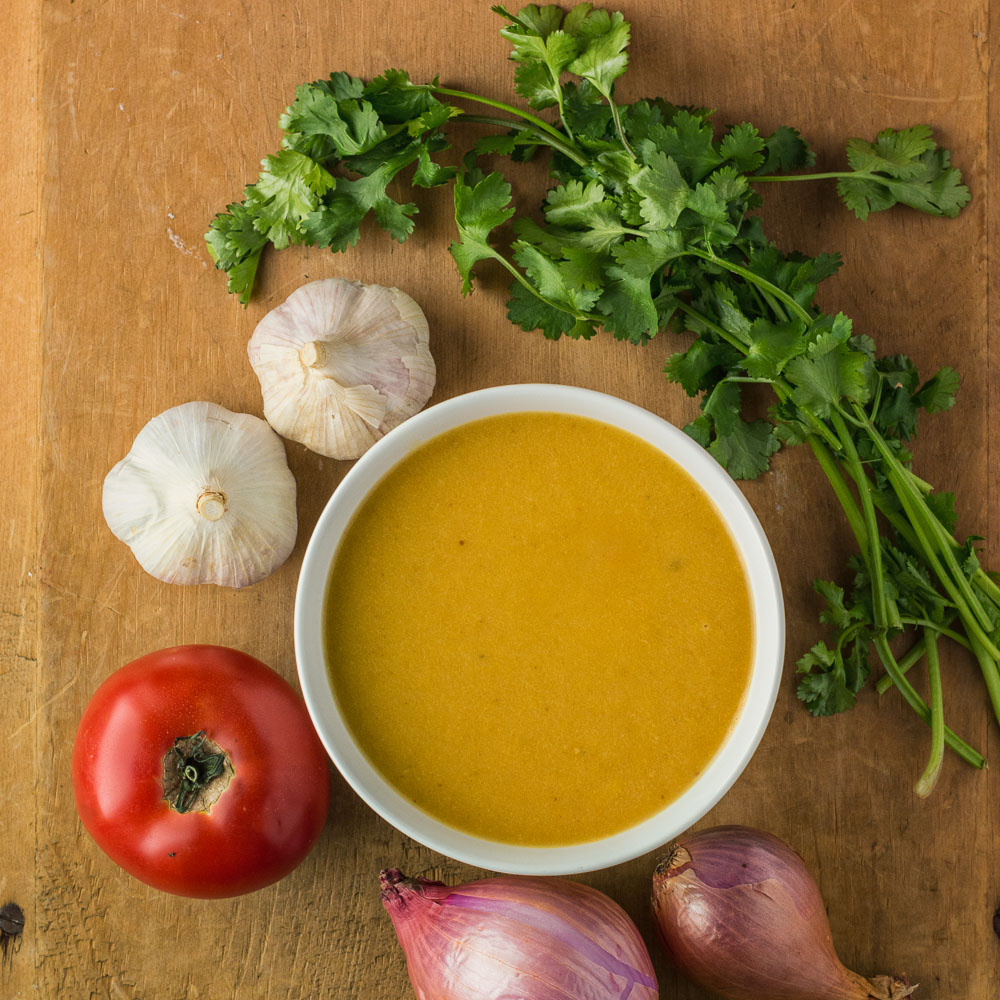

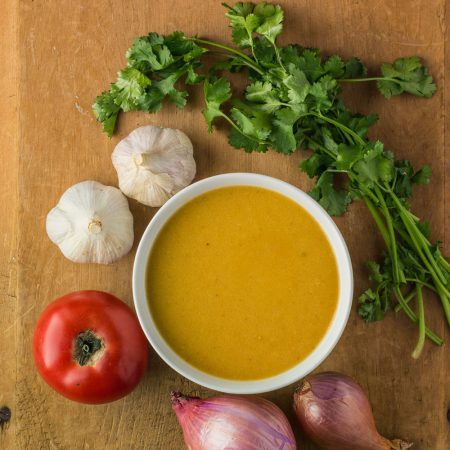
I first came upon this method of restaurant style curry base 27 years ago in a British cook book. I made a few but gave up because the gravy gave off a pretty foul odour. I never worked out why. This method is pretty much identical but the taste and flavour are much improved. Sorry though, Romain, I just can’t bring myself to use that much oil in the gravy! I want to live a few more years. It doesn’t make so much of a difference and if you like oily curry, there is plenty of opportunity to add it into the final stages. I have had cookery lessons at home from the great chef Monisha Bharadwaj and she never puts this much oil in her dishes, no matter which Indian region she is cooking from. Mind you, she does rather concentrate on authentic home cooked food rather than oily, creamy, restaurant/ hotel style which, as you say is a different type of cooking altogether. I suppose what I am saying, and Romain has also said, is that there are many ways to cook a dish to your preference. Indeed, the regional variations of style and flavour across India is so huge that there is room for everyone, it seems. Keep up the good work, Romain. You have some lovely recipes and a wonderfully uncomplicated way of making them.
Glad to hear it turned out better than your previous attempts! On the subject of oil, there is a lot of oil in restaurant style cooking. That is part of the “taste”. Definitely not food for everyday. The recipes on glebekitchen tend to be zero compromise but I’m glad to hear it worked out for you with less.
Great recipes. Made this 4 or 5 times and it NEVER disappoints.
I even mentioned it to a friend of mine who owns the local Indian restaurant and he said it’s pretty much exactly the same as he does.
One thing I have always wondered is, when we simmer at the end to separate the oil from the gravy, is this covered or uncovered?
Or doesn’t it matter?
Matt.
I leave it covered to cut down on evaporation.
Such a nice simple recipe. Other ones I have tried don’t put in nearly as much oil and I think that is probably what they lack. I am making this now and will try it as a base for a dopiaza.
I notice there is no carrot or bell pepper in this. I might make a batch with and without to see the difference.
I’m not a fan of carrot or bell pepper or cabbage in curry base personally. I find it colours the flavour of all the curries I make with it. But go with what you like. Always go with what you like!
Absolutely quality recipe and instructions! Thank you! I made the curry I’ve always wanted to, but not known how. It definitely is restaurant style, and you clearly know what you’re talking about!
Thanks for saying. Hope you find lots of recipes here that you enjoy!
Hi
I just love how you have given all information on your recipes I appreciate it so much, I’m just about to start the curry base but a quick question 1 and half tablespoons is what in weight please as tablespoons in my house are different sizes. Much appreciated regards Steve
Weight is a little tricky as I would have to go off and measure different spices to get accurate numbers. I can give you volume to help you dial in your spoons though. 1 tablespoon is 14ml.
Thanks made another today and got it thicker, i think i’ll make everything on this website, can’t wait!
Awesome to hear!
Amazing, i’ve cooked many curries but using this curry base is a game-changer, really delicious sauces thank you!
First curry i made wasn’t quite thick enough though maybe i need to cook the base on a higher heat when mixing it into the spices.
Awesome to hear. Do push the temp when you are cooking your curry after the first ladle of curry base.. Not only does it reduce but you get all the wonderful Maillard flavours. Maybe don’t go crazy at first but as you get more comfortable start experimenting. And welcome down the rabbit hole Alice:-).
Making this for the second time, and I have a question. A large peeled onion weighs around 2/3 to 3/4 of a pound. 8 large onions therefore weigh waaay more than 2.5 lbs. I went with the 8 large as before because it came out awesome, but a little clarification might help. TIA.
Onions vary dramatically in size. What passes for large here comes out at about 2 1/2 lbs trimmed weight. That’s why I gave the weight in the recipe. But if you are liking your results, I don’t see a reason you should change. The flavour profile will change a bit but as long as your base tastes like thin, vaguely curry flavoured and mild onion soup you should be fine. The real flavour is in the spicing and technique.
Hi, I made this yesterday to go along with your Chicken Tikka Masala recipe I’m going to make today. I’ve never really cooked Indian food properly before so you can imagine how ecstatic I am that I found your website! I just want to say the curry base came out brilliantly! The flavour is mild but even so it already tastes really good! I am very excited to make your curries and I want to try them all now ahaha! Thank you and I hope you continue your work here.
You are welcome. Hope you find lots of things you enjoy cooking here!
The largest pot I own is a 24cm Le Creuset which only holds 4.2 Liters, so I was only able to use 1.5 Liters of water. Hopefully adding water during the curry cooking process doesn’t dampen the flavors!!
It’s on the stove right now and I’m super looking forward to making the eggplant restaurant-style curry later. As a suggestion/requestion – I’ve noticed you don’t have very many vegetarian indian recipes, which I find odd as around 40% of India is vegetarian. I myself have been vegetarian for the last 22 years. I would find it super helpful if you either added to your guide 1. how to adapt other website’s vegetarian curries to using your spice/currry/garlic-ginger bases or 2. added more vegetarian curries to your website. (I know I can just sub vegetarian chicken in the chicken recipes, but you know what I mean)… Anyway, I found your blog after a daal recipe internet spiral. I still haven’t found any recipes that come close to the daal from my favorite spot though… I really enjoy your writing style and I immediatly made up a batch of your indian restaurant spice mix for a bikepacking trip I went on.
Thanks for your passion and writing about it!
I’m glad you like the writing!
You could dilute your curry base a bit before cooking (rather than try diluting the curry itself). Reason for that is you really want to fry your curry base hard to get the Maillard flavours when making the curry. That should work fine.
I am (obviously) not a vegetarian and I am not writing for an Indian audience so I don’t do as many vegetarian recipes as I probably should. India is well served by many blogs, websites and YouTube channels with everything presented in Hindi. I am writing for the rest of the world.
I am also not the voracious carnivore you might think by looking at the recipes on glebekitchen. It’s just that the people who are going for restaurant style want chicken. Or lamb. My vegetarian recipes don’t get much love at all.
That said, I do have a few tricks.
For just about any of the restaurant style (I haven’t experimented with hotel style), you can swap out the protein for paneer.
I find paneer a bit rich for my taste so I often swap out the protein for chickpeas. I quite like that. It works with just about any of the meat based curries.
Another thing I do is cook up about a cup of masoor dal with just some turmeric (salt at the end to taste). I then make any of the dishes and fold the curry sauce (no protein) into the dal. I call that anything dal. So if you feel like a saag dish – make it without the chicken and fold it into the dal. Feel like a dish with peppers and onions, make a jalfrezi without protein and fold it into the dal. And so on.
You could also use roasted eggplant or fried cauliflower or potato in lieu of the protein.
Hope that helps.
Is it possible to make this base for one meal? Instead of making a big batch.
What would I do different and how about the ingredient amounts?
If you want to just make one meal I’d suggest looking at the nearly restaurant recipes here instead.
Thank you for such a quick response. I’ll make a batch of the base and try a couple of your of restaurant recipes tonight. I’ll also have a look at your hotel style base. Love your passion for great curry.
Passion for food actually. All food…
Can you explain the Maillard reaction – if this base is just simmered, surely it wouldn’t get hot enough to get that reaction to occur – or does that magic happen later during the curry construction? Do Indian restaurants do this type of simmered base or do they brown the onions ala French onion soup to get the reaction at the base stage?
Ps. Made one if your “almost” recipes and it was the best curry I’ve ever made at home. Ever.
Glad you liked the almost restaurant curry. It’s a great time saver and it really works.
Most Indian restaurants outside of India use the curry base approach. Maillard happens above around 285F so it is happening in the pan when you fry the curry base when making your final curry.
I am also posting on a series of recipes I call hotel base which do rely on a gravy that is more aligned with really fancy Indian restaurants around the world and fairly common in restaurants in India.